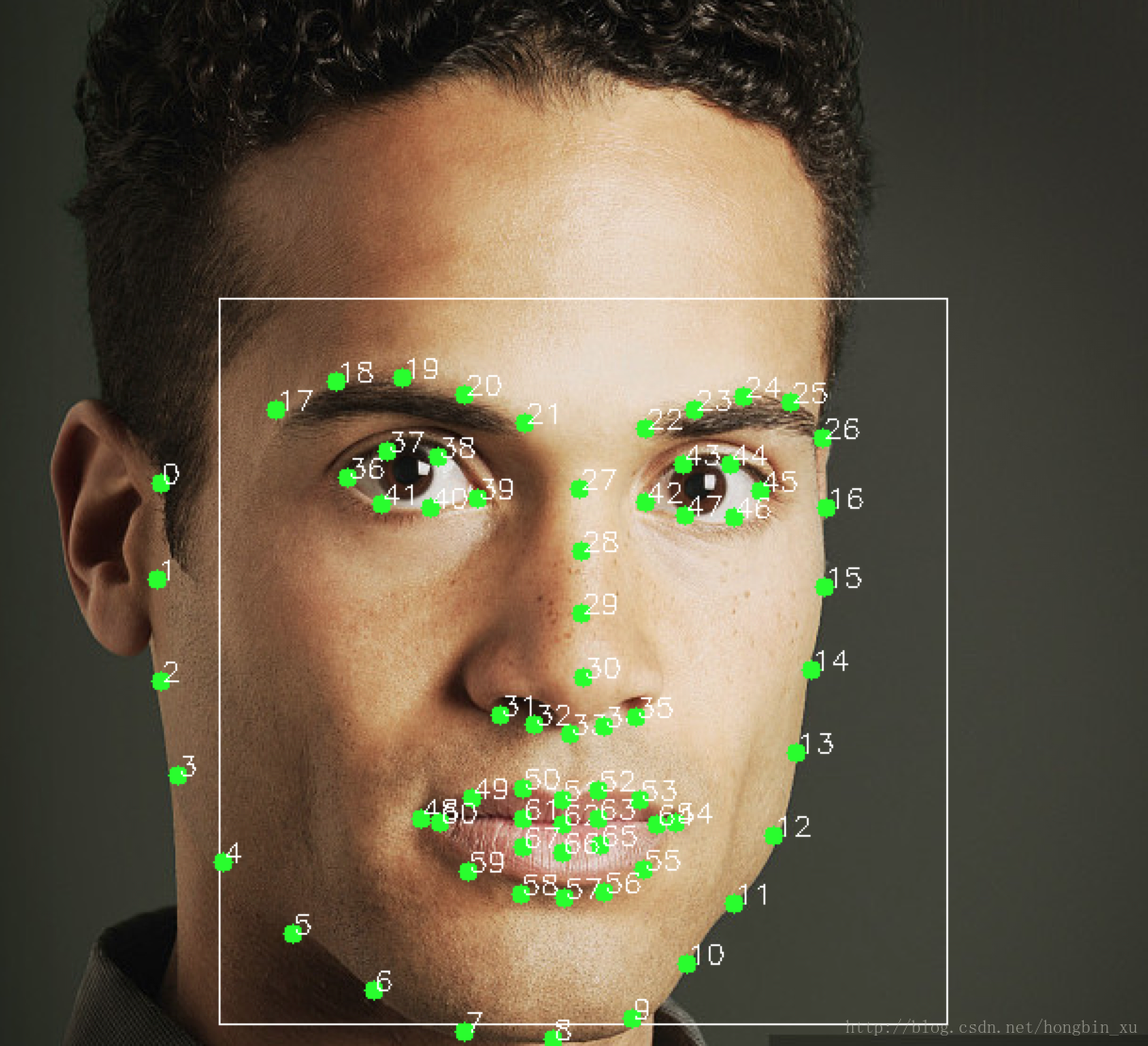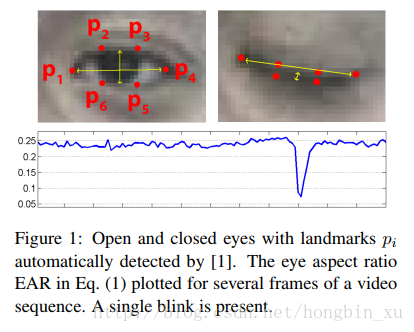流程
本节总结下初步完成人脸动作检测登录的流程:
用户进入登录界面
->点击面部动作检测登录
->用户点击start开启摄像头
->待人脸进入摄像头范围,点击Start Recording开始录像
->在2s录像中完成动作(初步是完成眨眼两次检测),前端自动上传该2s视频
->后台根据前端传来的数据,进行解析,获得结果后传回前端
->前端接收返回结果,成功,则跳转进入系统;失败则要求用户重新登录
注:旁边的play按钮方便用户查看上传到服务端的2s视频
实现
前端解读
在用户模板页面添加显示标签和点击按钮
1
2
3
4
5
6
7
8<video id="gum" playsinline autoplay muted></video>
<video id="recorded" playsinline loop></video>
<div>
<button id="start">Start camera</button>
<button id="record" disabled>Start Recording</button>
<button id="play" disabled>Play</button>
</div>
接下来是前端的js代码,我们基于的是webrtc官网的参考代码
1 | 'use strict'; |
在这里,主要是几个函数,涉及的中心是对MediaRecorder接口的应用,我会一一进行讲解
1 | let mediaRecorder; |
这里是获取页面元素及对record按钮的点击事件进行处理,对每一次record点击,显示在“Start Recording”和“loading”间切换,在Start Record前,将play按钮设置为点击无效
1 | const playButton = document.querySelector('button#play'); |
这里是对播放按钮的点击事件进行处理,这里是将获取到的recordedBlobs流处理对象赋值给新的Blob流处理对象,并作为视频源url赋值给recordedVideo元素,这样recordedVideo元素就能播放刚刚录制的视频了(关于Blob的更多描述,可以参看其官网)
接下来四个函数是对点击按钮record后视频录制的处理
1 | function handleDataAvailable(event) { |
该函数是对mediaRecorder.ondataavailable事件的处理,主要触发情况有两个,一个是我们设定的录制时间到了,一个是我们触发了 MediaRecorder.stop()事件,此时,会传进一个event对象,里面的data就是我们录制的视频数据,我们可以通过formData.append()封装数据,用ajax传至后台,在后台通过request.File[]可以获取到该视频录制数据
1 | function startRecording() { |
这里是我们开始视频录制的函数,首先,我们通过MediaRecorder.isTypeSupported可以查询到我们的浏览器是否支持webrtc所需的编解码(编解码是由浏览器提供的),webrtc默认的video是webm格式,获取到编码类型后我们新建MediaRecorder对象,传入的参数window.stream是我们一会儿通过navigator.mediaDevices.getUserMedia获取到的,也就是我们主机媒体设备的媒体流,将play按钮设置为点击有效,改变reord按钮的显示文本,设置mediaRecorder.onstop事件的处理程序,设置mediaRecorder.ondataavailable的处理程序,mediaRecorder.start(2000)设置我们的录制时间为2s
注:这里所有的console.log是为了方便我们在浏览器的console界面进行运行变量观察
1 | function stopRecording() { |
这个函数是当record按钮在“Loading”状态点击时调用的函数,它会调用mediaRecorder.stop()函数,并触发mediaRecorder.ondataavailable事件
1 | function handleSuccess(stream) { |
成功获得用户许可拿到媒体流后的处理函数,开启record按钮点击有效,将获得的媒体流stream赋值给window.stream方便后面将流数据记录,同时对gum元素赋值,用来将媒体流实时显示
接下来的两个函数,是对用户点击Start按钮后获取webcam媒体流的初始化处理;
1 | async function init(constraints) { |
该初始化函数询问用户来获取媒体流权限,前面声明async来说明这是一个异步函数,函数中的await会使函数暂停执行,等待Promise的结果出来,若成功获取媒体流权限,则将媒体流传入handleSuccess函数,进行下一步处理;反之,对errorMsgElement元素赋值来显示错误信息
1 | document.querySelector('button#start').addEventListener('click', async () => { |
当用户点击Start按钮后,触发该async调用,在这里设置对媒体流的约束变量constraints,然后传入并调用init函数,等待用户赋予媒体流权限
后台解读
1 | @csrf_exempt |
这里涉及ffmpy3、cv2、face_recognition等对媒体文件进行处理的包,其中ffmpy3是基于ffmpeg工具,我们需要预先对其安装,可去官网下载
我们在这里将该部分功能拆分为5个函数,对眨眼检测的总体处理流程是:首先从前端获取用户视频,用ffmpeg将视频解析为每秒25帧的图片集,对每帧图片检测其中人脸的68个标记点

根据参考论文中的描述眼睛纵横比(eye aspect ratio (EAR))的概念,可以取出68个标记点的左右眼部分,计算眼睛纵横比,设定一个阈值,将ear值与阈值对比,大于阈值判断眼睛为睁开状态,反之则判断为闭眼状态,最后顺序处理每张图片的眼睛状态来获得总共的眨眼次数
1
2
3
4
5
6
7
8
9
10
11
12
13
14
15
16
17
18
19
20
21
22
23
24
25
26
27
28
29
30
31
32
33
34
35
36
37@csrf_exempt
def test(request):
if request.method == "POST":
start = time.clock()
videos = request.FILES['faceVideo']
fileName = 'temp.webm'
# file = uploadedfile.File(videos)
with open(fileName, 'wb') as f:
for chunk in videos.chunks():
f.write(chunk)
end = time.clock()
print("video_get_write:", end - start)
start = time.clock()
num = detection_blink()
end = time.clock()
print("Blink_video_stream:", end - start)
files = glob.glob(os.path.join('.', "*.jpg"))
imgName = files[int(len(files) / 2)]
jsonInfo = auth_user(imgName)
os.system('del *.mp4 *.webm *.npy')
JsonBackInfo = {
"canLogin": jsonInfo['canLogin'],
"AuthName": jsonInfo['AuthName'],
'blink_num': num
}
if jsonInfo['AuthName'] != "未授权用户" and num == 2:
user = User.objects.get_by_natural_key(username=jsonInfo['AuthName']) # authenticate(username='admin', password='123456')
if user is not None:
if user.is_active:
ori_login(request, user)
return JsonResponse(JsonBackInfo)
else:
return render(request, 'test.html')
该函数前面的装饰器csrf_exempt是用来说明访问下面的函数前可以不用csrf_token验证,这是处理眨眼检测请求的主函数,请求为“get”时,渲染眨眼检测模板页面并作为结果返回用户;当请求为“post”时,通过request.FILES[‘faceVideo’]来获取传至后台的媒体文件,为避免因文件过大而无法写入的问题,这里调用UploadFile.chunks()方法读取并用write()将上传文件存入后台文件系统,接下来调用detection_blink()进行眨眼检测,返回眨眼次数存入num,获取视频中间的一帧调用auth_user(imgName)来进行登录用户匹配,构造Json用来返回用户数据
1
2
3
4
5
6def translate(infile, outfile):
ff = ffmpy3.FFmpeg(
inputs={infile: None},
outputs={outfile: '-r 25 -y'}
)
ff.run()
该函数用ffmpy3将infile以每秒25帧的帧率转换成outfile,目的是将webrtc的webm视频格式转换为mp4格式,以便opencv提取每一帧的数据(opencv无法解析webm格式)
1
2
3
4
5
6
7
8
9
10
11
12
13
14
15
16
17
18
19
20
21
22
23
24
25def video2frame(videofile):
# 读取视频
cap = cv2.VideoCapture(videofile)
# 获取FPS(每秒传输帧数(Frames Per Second))
fps = cap.get(cv2.CAP_PROP_FPS)
# 获取总帧数
totalFrameNumber = cap.get(cv2.CAP_PROP_FRAME_COUNT)
print(fps)
print(totalFrameNumber)
# 当前读取到第几帧
COUNT = 0
# 若小于总帧数则读一帧图像
while COUNT < totalFrameNumber:
# 一帧一帧图像读取
ret, frame = cap.read()
# 把每一帧图像保存成jpg格式(这一行可以根据需要选择保留)
cv2.imwrite(str(COUNT).zfill(3) + '.jpg', frame)
# 显示这一帧地图像
# cv2.imshow('video', frame)
COUNT = COUNT + 1
# 延时一段33ms(1s➗30帧)再读取下一帧,如果没有这一句便无法正常显示视频
# cv2.waitKey(33)
cap.release()
使用cv2将转换后的mp4视频提取出每一帧,保存在本地
1
2
3
4
5
6
7
8
9
10
11
12
13
14def eye_aspect_ratio(eye):
point0 = eye[0]
point1 = eye[1]
point2 = eye[2]
point3 = eye[3]
point4 = eye[4]
point5 = eye[5]
temp = math.pow(point1[0] - point5[0], 2), math.pow(point1[1] - point5[1], 2)
distance1 = math.sqrt(math.fsum(temp))
temp = math.pow(point2[0] - point4[0], 2), math.pow(point2[1] - point4[1], 2)
distance2 = math.sqrt(math.fsum(temp))
temp = math.pow(point0[0] - point3[0], 2), math.pow(point0[1] - point3[1], 2)
distance3 = math.sqrt(math.fsum(temp))
return (distance1 + distance2) / (2 * distance3)
传入一只眼睛的6个标记点列表,眼部的标记点如下

根据以下公式计算ear值

返回眼睛的EAR值
1
2
3
4
5
6
7
8
9
10
11
12
13
14
15
16
17
18
19
20
21
22
23
24
25
26
27
28
29def detection_blink():
num = 0
left_blink, right_blink = (False, False)
infile = 'temp.webm'
outfile = 'temp.mp4'
translate(infile, outfile)
video2frame(outfile)
files = glob.glob(os.path.join('.', "*.jpg"))
for f in files:
unknown_face = face_recognition.load_image_file(f)
locate_unknown_face = face_recognition.face_locations(unknown_face)
landmards = face_recognition.face_landmarks(unknown_face, locate_unknown_face)
left_eye = landmards[0]['left_eye']
right_eye = landmards[0]['right_eye']
left_ear = eye_aspect_ratio(left_eye)
right_ear = eye_aspect_ratio(right_eye)
if left_ear < 0.20:
left_blink = True
if right_ear < 0.20:
right_blink = True
if left_ear >= 0.20 and right_ear >= 0.20 and left_blink and right_blink:
num += 1
right_blink = False
left_blink = False
return num
该函数整合以上处理函数,调用translate函数将webm转换为mp4格式,调用video2frame将mp4文件转换为帧集,对每一帧数据调用face_recognition.face_locations函数(HOG+SVM)先获得人脸位置,再通过face_recognition.face_landmarks函数,获得该图片中人脸的68个标记点,对于眨眼视频,我们通过检测眨眼瞬间的次数来简单的代表眨眼次数,若两个眼睛的前几帧检测到状态均有闭眼时,当出现一次两只眼睛均睁开的状态时,我们就认为出现了眨眼瞬间,记为一次眨眼,累计眨眼次数并返回给调用函数
注:face_recognition.face_landmarks是调用dlib中的shape_predictor函数,该dlib函数传入的一个参数是姿态检测器路径,有一个68个标记点的姿态检测器是dlib结合CVPR 2014年论文《One Millisecond Face Alignment with an Ensemble of Regression Trees》与iBUG 300-W人脸数据集训练得来的,该检测器可通过该url获得